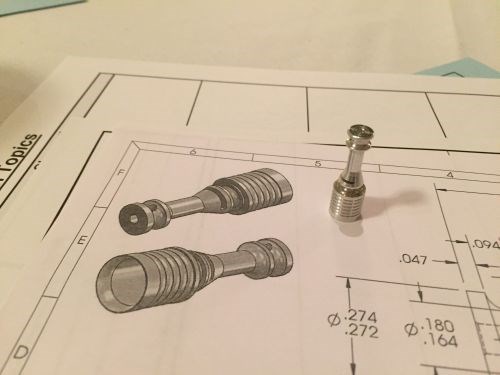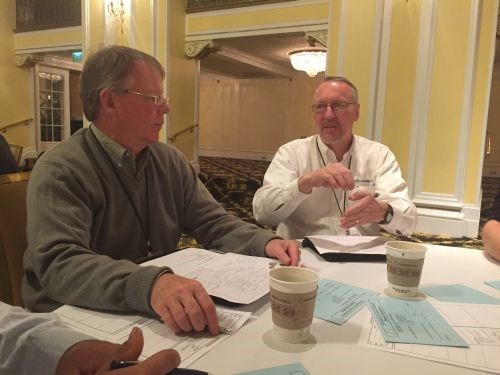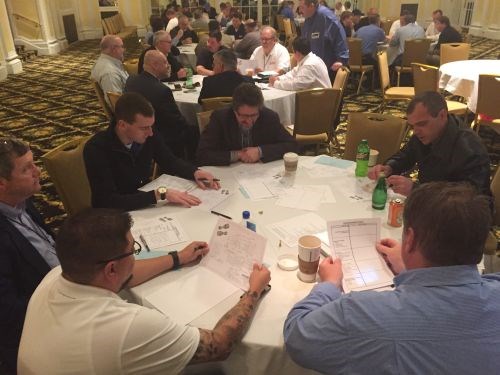An Exercise in Part Production
When you put together a team of engineers, programmers and machine tool builders to develop a plan for making a part, you’ll realize the true role of imagination and creativity in the manufacturing process.
Share







One of the most popular conference tracks at the PMPA National Technical Conference were sessions in which prints—and often part samples—with certain key parameters were provided to groups for roundtable discussions of the best way to machine the part.
When visiting a shop, I am particularly interested in the process behind determining the best way to machine a part from the prints provided by the customer. So many things must be taken into consideration—in fact, nothing can be left to chance. In order to meet the customer’s requirements, and to reach the lowest cost per part in order to win the bid, here are the top 12 considerations I’ve noted, although there are certainly more depending on the part in question:
- Best machine tool/process
- Risks/benefits of each process
- Geometry/features of the part
- How to machine with fewest setups/lowest cycle times
- The best approach to workholding/fixturing
- Best type of stock to use
- How much cross-drilling and backworking, etc., will be required?
- Best means of conducting measurement/inspection
- Chip generation (types, amounts, etc.)
- What is the purpose of the part?
- How will deburring be accomplished?
- What type of surface finish is required?
I was able to witness an especially intense example of this exercise at the recent (PMPA) National Technical Conference in Grand Rapids, Michigan, April 9-12 ( in Production Machining magazine). In addition to the presentations made during the three-day event—Rotary Transfer, Speeds and Feeds, CNC Programming, Additive Manufacturing, Exotic Materials, etc.—I sat in on a group discussion among operators, engineers and programmers as they worked from a blueprint to identify the optimal machines, tooling and processes for manufacturing the part in question. Three of the sessions were structured in this way.

Each team, generally consisting of five to six members, discussed the plan and the related part to begin developing a machining approach. Everything from part geometry, to material, to machining methods and tooling were examined, including deburring and surface finishing.
It was fascinating to observe the thought process behind deciding how you get from a hunk of metal to a detailed, often geometrically complex finished part with the lowest cycle times, the fewest setups, and a process where each step logically leads to the next. I’ve sat down with individual shop owners (see this article from a recent issue) as they’ve explained the logic behind their decisions, but to witness a group discussion in which everyone discussed their personal experiences—both victories and failures—and the tricks they’ve learned along the way for making deburring part of a machining step, or developing fixturing that made setups easier to accomplish gave me new respect for all the thought and planning that goes into machining parts from raw materials.

The audience was a mix of engineers, programmers and machine tool builders. Their different perspectives and experiences made for lively conversations.

At the conclusion of the discussion period, a representative of each table addressed the hall, describing the group’s machining path, including the reasoning behind the decisions they’d made. Once their presentations had been made a member of the company that provided the part and print—in this case, Don Corwin of Buell Automatics—revealed the backstory, including the part’s history, intended usage, and current manufacturing status.
Read Next
Last Chance! 2025 Top Shops Benchmarking Survey Still Open Through April 30
Don’t miss out! 91ÊÓƵÍøÕ¾ÎÛ's Top Shops Benchmarking Survey is still open — but not for long. This is your last chance to a receive free, customized benchmarking report that includes actionable feedback across several shopfloor and business metrics.
Read MoreAMRs Are Moving Into Manufacturing: 4 Considerations for Implementation
AMRs can provide a flexible, easy-to-use automation platform so long as manufacturers choose a suitable task and prepare their facilities.
Read MoreMachine Shop MBA
Making Chips and 91ÊÓƵÍøÕ¾ÎÛ are teaming up for a new podcast series called Machine Shop MBA—designed to help manufacturers measure their success against the industry’s best. Through the lens of the Top Shops benchmarking program, the series explores the KPIs that set high-performing shops apart, from machine utilization and first-pass yield to employee engagement and revenue per employee.
Read More














